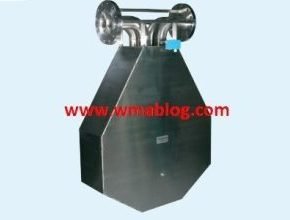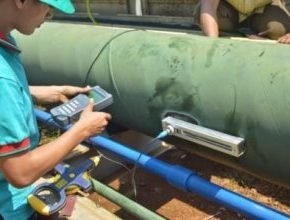The Measurement Principle
Each mass flow meter has two measuring tubes. The oscillating system is driven by two controlled electromagnetic excitation coils. As liquids or gases flow through the oscillating omega tubes, the Coriolis force is created and causes a slight deflection of the two measuring tubes from their original shape.
The opposing tubes are referenced to each other and the changes in deflection are proportional to the mass flow rate. In practice, the referencing is done by attaching small pickup coils that generate sinusoidal voltages. The degree of deviation of the phase shift is directly proportional to the mass flow.
The RHM 160 is the ultimate cargo and pipeline meter. With a combination of high accuracy and low-pressure drop, the RHM 160 is the perfect solution for rapidly transferring large fluid quantities with confidence.
- Range: 250 kg/min up to 30000 kg/min
- Pressure: up to 52 bar (754 psi)
- Temperature: -196°C (-321°F) up to +120°C (248°F)
- Accuracy: 0.1 % of rate
- Materials: SS 316L / SS 316Ti, Alloy C22 – 2.4602
- Process Connection: 12″ up to 12″
Features
- Standard Pressure ratings up to 50bar (725 psi)
- Temperature ratings from -196 to 120°C (-320 to 248°F)
- Mass flow uncertainty down to 0.15%
- Density uncertainty down to 0.5%
- Repeatability better than 0.05%
- Typical measuring ranges between 750 and 30000 kg/min
- Accurately measure low flow rates down to 600 kg/min
- Unique robust torsion has driven oscillation system
- Approved for use in hazardous areas
- Stainless steel case
- Remote and compact transmitter versions are available
Applications
- TerminalTransfer
- Allocation Metering
- Viscous Fluids
- Barge, Ship, Rail Car, and Truck Filling
Benefits
- Torsionoscillator design assures a stable and drift-free measurement with excellent signal-to-noise ratios
- Resilient external noise and vibration
- Insensitive to pipe pressure changes
- Robusttube wall thickness provides increased operational safety in abrasive applications
- Corrosion-resistant
- Long sensor life is guaranteed due to low mechanical stresses in the meter mechanism
- No moving parts to wear or fail
RHM6 General Specifications
| Nominal Flow (Qnom)* | 30000 kg/min (66139 lb/min) |
| Minimum Flow (Qmin)* | 750 kg/min (1653 lb/min) |
| Operating Temperature | Fluid from -196°C to 120°C (-320°F to 248°F), see options in Part Number Code |
| Ambient from -50°C to 80°C (-58°F to 176°F) | |
| Pressure Ratings | Up to 50 bar / 725 psi – dependent upon material |
| Electrical Connection | Cable entry M25 x 1.5 (standard), M20 x 1.5, ½” NPT, ¾” NPT (optional) |
| Max. cable length to remote RHE transmitter 30m / 98ft | |
| Sensor Enclosure Materials | Stainless steel (standard), 316 stainless steel (optional) |
| Epoxy coated aluminum terminal box (standard), SS 316 terminal box (optional) | |
| Enclosure Type | Protection class IP66 / NEMA 4X with Standard Temperature Range (Option N1/NA); IP65 / NEMA 4 for Extended Temperature Ranges (Option E3) |
| Wetted Materials | 1.4571 (316Ti), 2.4602 (Alloy C22) |
| Additional/customer specific materials available upon request | |
| Process Connections | Nearly any – the RHEONIK AnyPipeFit Commitment. Consult factory for types/sizes not listed |
| Pressure Rating Compliance | Europe – PED: Module B3.2+C2 |
| Certifications and Approvals | ATEX / IECEx Approvals for zone 0, 1, 2 (suitably rated RHE transmitter required) |
| North American Approvals for Class I, Div. 1, Groups ABCD (suitably rated RHE transmitter required) | |
| American Bureau of Shipping (ABS) Type Approval for use on marine vessels | |
| Documentation, Testing and Inspection | All sensors are hydro tested, calibrated and supplied with a traceable calibration certificate. Customized calibration and testing services available |
| Project Documentation and QA, Services | Rheonik offers a full set of services for large and complex engineering projects. Typical services offered are, but not limited to: |
| •Certificates of origin and conformity, mill certificates | |
| •Data books including WPAR, WQS, NDT, test & quality plans, functional testing, calibration procedures, customized packing, factory acceptance etc. | |
| •Start up and commissioning services on/offshore | |
| Options | Enclosure heating for high temperature applications |
| Cleaning for oxygen service | |
| Full service painting to project specifications – consult factory |
- At Qnom pressure drop will be approximately 1 bar (14 psi) for H20. Sensors can be operated at higher flow rates but pressure drop will be higher. Maximum recommended velocity (liquid) through the sensor is 15 m/s. Beyond this point, cavitation may occur. Qmin is the recommended lowest flow rate. Sensors will measure flow rates lower than Qmin, but uncertainty may increase beyond 0.5% of rate.
These flow rate and pressure drop statements relate to standard pressure tube sensor versions. Models with higher pressure ratings have increased wall thickness and will have higher pressure drops and lower Qnom values.
Kind of Coriolis Mass Flow Meter from RHEONIK
Small Size Coriolis Mass Flow Sensor
Ideal for embedded systems and precise small-flow applications
- RHM 015 Low Flow Mass Flow Meter flow rate
- RHM 02 Low Flow Mass Flow Meter flow rate
- RHM 03 Low Flow Mass Flow Meter flowrate
- RHM 04 Low Flow Mass Flow Meter flow rate
- RHM 06 Low Flow Mass Flow Meter flowrate
- RHM 08 Low Flow Mass Flow Meter flow rate
Medium Size Coriolis Mass Flow Sensor
Suited to industrial and process flow control and monitoring
Large Size Coriolis Mass Flow Sensor
Perfect for material movements in small and wide-scale operations
- RHM 60 Coriolis Flow Meter flow rate
- RHM 80 Coriolis Flow Mass Meter flow rate
- RHM 100 Coriolis Flow Mass Meter flow rate
- RHM 160 Coriolis Flow Mass Meter flow rate
The types of Coriolis Mass Flow Transmitter
- Rheonik RHE16 Coriolis mass flow transmitter Compact Multifunction
- Rheonik RHE15 Profibus DP Module
- Rheonik RHE21 explosion proof field mount Mass Flow Transmitter
- Rheonik RHE 26 Coriolis Mass Flow Transmitter
- Rheonik RHE 27 Coriolis mass flow transmitter
- Rheonik RHE28 Field / Wall Mount Coriolis mass flow transmitter
- Rheonik RHE45 Compact Mount Coriolis Mass Flow Transmitter
- Rheonik RHE42 Coriolis Mass Flow Transmitter
For information Price, stock and other please contact : WMA
Other Articles
- Flow Meter Open Channel Untuk PLTU
- Instalasi Flow meter ultrasonic clamp on untuk air dingin mesin chiller
- Prosedur Instalasi Flow Meter Electromagnetic
- Meteran air Jenis flow meter Ultrasonic
- Flow meter ultrasonic clamp on untuk pipa HDPE
- Flow Meter Ultrasonic Jenis Clamp On Untuk Pipa PVC
- Harga Coriolis Mass Flow Meter
- Perlunya Resetting dan Kalibrasi Flow meter secara berkala






